Original Title: Ethereum Foundation Report
Original Author: Ethereum Foundation
Original Translator: Odaily Planet Daily
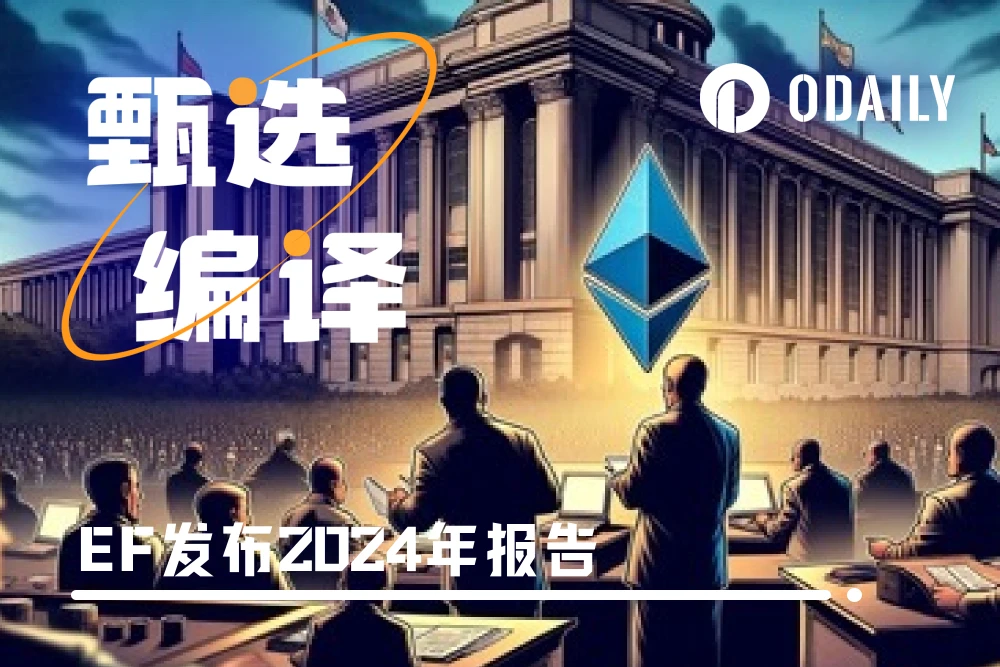
What is the Ethereum Foundation?
The Ethereum Foundation (EF) is a non-profit organization that supports the Ethereum ecosystem, composed of a community of organizations, individuals, and companies that fund protocol development, grow the community, and promote Ethereum.
EF is at the forefront of a new type of organization: supporting the blockchain ecosystem without controlling it. This leads everyone to think daily about what kind of organization EF needs to become to support the long-term development of Ethereum.
EF itself is divided into many separate teams and believes that small autonomous teams are the most effective structure for getting work done. New teams typically grow organically by forking existing teams in response to new needs in the ecosystem.
EF teams contribute to many different parts of the Ethereum ecosystem. Some teams build software or explore the cutting edge of the Ethereum roadmap; some teams help nurture the ecosystem of developers and users around the world; others help promote the utility and potential of Ethereum to the world.
Core Values
Over the past 10 years, EF has experienced the ups and downs of Ethereum's brief history.
This experience has taught us many lessons. Over time, three important ideas have emerged that help guide EF and inform our decisions.
Here are our three core values: long-term thinking, subtraction, and value management.
Long-term Thinking
Ethereum is still relatively young, and the ecosystem sometimes focuses on very short-term goals and cycles. EF should balance this trend: looking beyond the peaks and troughs of market cycles and focusing on long-term prospects. This means EF is willing to take actions now that may not yield returns for years or even decades, or that may not yield any results at all.
Subtraction
Subtraction means we do not try to accumulate power and prestige. Our success is measured by the achievements of the Ethereum ecosystem, not by the achievements of EF. We are happy to give credit to others, support independent organizations, and work quietly behind the scenes.
Subtraction stems from an observation: organizations—non-profits—naturally desire to accumulate power. But this cannot happen in an organization like EF that supports decentralized blockchains; to counter this default path, EF needs to take proactive measures.
Value Management
Ethereum is not just a technology. It is a community bound by a set of shared values, with a vision of how these values can improve the world. The Ethereum ecosystem stands on the shoulders of the long history of the open-source and cypherpunk communities, paving the way for us.
EF Activities and Expenditures
Ethereum Foundation Teams
EF includes many teams that contribute to the Ethereum ecosystem across a wide range of areas. Most teams contribute to important Ethereum infrastructure, while a few others research and manage the Ethereum roadmap or help coordinate the ecosystem. Team examples include:
Robust Incentives Group (RIG): Focused on Ethereum mechanism design and cryptoeconomics research. RIG's work outlines all the ways incentives directly or indirectly affect Ethereum users and protocol stakeholders. Where possible, RIG proposes mechanisms to restore incentive compatibility and system optimality.
Protocol Support Team: The protocol support team ensures that Ethereum has the right people, processes, and perspectives to support its long-term maintenance. In practice, this team helps facilitate network upgrades (AllCoreDevs, EL specifications), attract and retain protocol contributors (Ethereum Protocol Fellowship), and undertakes various other projects related to Ethereum's sustainability.
Developer Conference (Devcon): Hosts and supports events like Devcon to promote collaboration, education, and the values and mission of Ethereum. As the community has grown, this team has expanded Ethereum's global impact through community-driven gatherings like Devconnect, support for global non-EF events, and the Road to Devcon funding program.
Ethereum Foundation Grant Projects
EF supports important work across the ecosystem through grants. Grants come in various sizes and forms, with many EF teams playing a role in approving and evaluating grants. The Ecosystem Support Program (ESP) regularly reports on grant activities. Grant examples include:
WTF Academy: WTF Academy produces free, open-source, concise, and community-reviewed tutorials for Web3 development tools, including Solidity, Ethers, etc., with a focus on Chinese content. ESP funding helped them expand their curriculum and translate more content into English. A grant of $30,000 was awarded in November 2022.
Security Alliance: The Security Alliance is dedicated to building a safer ecosystem. They do this through projects like Seal Team 911, the White Hat Security Harbor Protocol, their security framework, and Seal Team wargaming. Their efforts help projects and users through proactive security measures and passive incident handling, assisting in preventing fund losses. A total of $130,000 was awarded during 2022-2023.
Devcon University Roadshow: An event held at five universities in Thailand aimed at exposing students to the Ethereum ecosystem, educating them about Ethereum, and providing them with job opportunities. A grant of $10,000 was awarded in April 2024.
Evolving Ethereum Institutional Ecosystem
Ethereum is a vast global project. There is an incredible range and diversity of work at all levels of the Ethereum ecosystem around the world.
Today, many individuals and organizations contribute to this work, but there is still much to be done, especially in supporting and maintaining public goods. Relying on one or a few organizations to do most of the work poses a risk to the ecosystem.
This phenomenon has led EF to prioritize the development of many independent organizations that can strengthen and support the ecosystem, thereby sharing the responsibility for the health, maintenance, and development of Ethereum.
Over the past two years, EF has been committed to nurturing and supporting many new organizations that are driving the Ethereum ecosystem forward, such as Argot Collective, Geodework, L2BEAT, Nomic Foundation, and 0xPARC. We are very proud to work with them.
Argot Collective: Argot Collective is a newly established non-profit, democratic organization dedicated to maintaining Ethereum's freedom and independent software. Argot is composed of about 25 former Ethereum Foundation team members, including compiler engineers, programming language theorists, and verification experts, focusing on core infrastructure development without commercial pressure. Their mission emphasizes long-term sustainability and transparency, opposing profit-driven motives. Argot is the new home for the current Ethereum Foundation internal teams Solidity, Fe, Formal Verification, and Sourcify. While Argot is expected to retire in the future and launch new projects, they will be fully committed to the long-term maintenance and development of Solidity (Argot.org) as long as the community finds it useful.
Geodework: Geodework is a public welfare organization dedicated to the development of the Ethereum ecosystem and building a better internet. Its core focus is on pursuing geographic decentralization of Ethereum, which means building community and educational infrastructure and supporting local innovators and leaders around the world. In practice, Geodework facilitates funding, creates ecosystem tools, products, and services, and executes a range of projects aimed at strengthening the Ethereum community layer. Geodework is currently being developed within EF and will share more information in early 2025.
L2BEAT: L2BEAT provides analysis, research, and tools related to Ethereum's second-layer scaling projects. It was created to provide transparent and verifiable insights into emerging second-layer technologies aimed at scaling Ethereum and to monitor different second-layer technologies, primarily focusing on the security of user funds. L2BEAT tracks the progress of projects committed to becoming trust-minimized L2s. Their goal is to provide the community with up-to-date information about the status of these projects and to offer insights and guidance for achieving complete trust minimization.
Nomic Foundation: The Nomic Foundation is an early non-profit organization providing open-source engineering software, dedicated to advancing the development of the Ethereum ecosystem. Their ultimate goal is to ensure that Ethereum continues to provide a high-quality, reliable developer experience, and by doing so, help Ethereum and the broader decentralized movement realize their full potential, creating a world that offers more autonomy and choice to millions (economic foundation).
0xPARC: 0xPARC accelerates the development and deployment of programmable cryptography. They operate, fund, and support teams working across the stack. This includes research on zero-knowledge cryptography, multi-party computation, homomorphic encryption, and program obfuscation, as well as deploying these technologies into user applications like autonomous worlds and identity.
EF Expenditures in 2022
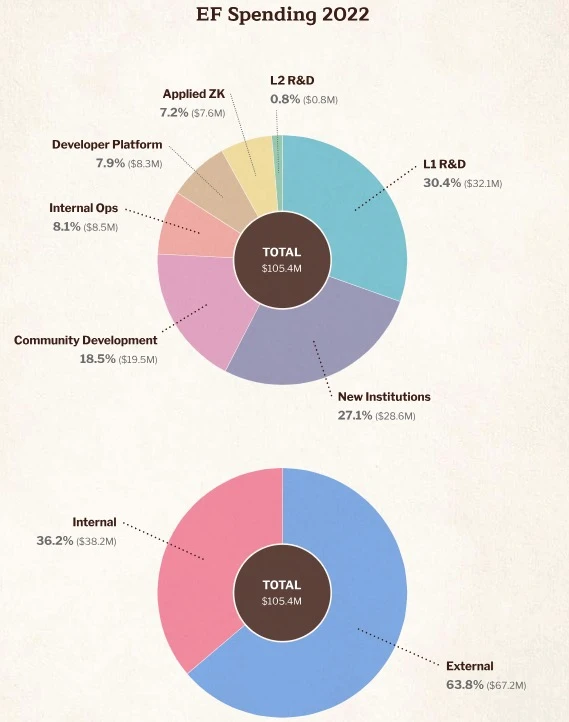
EF Expenditures in 2023
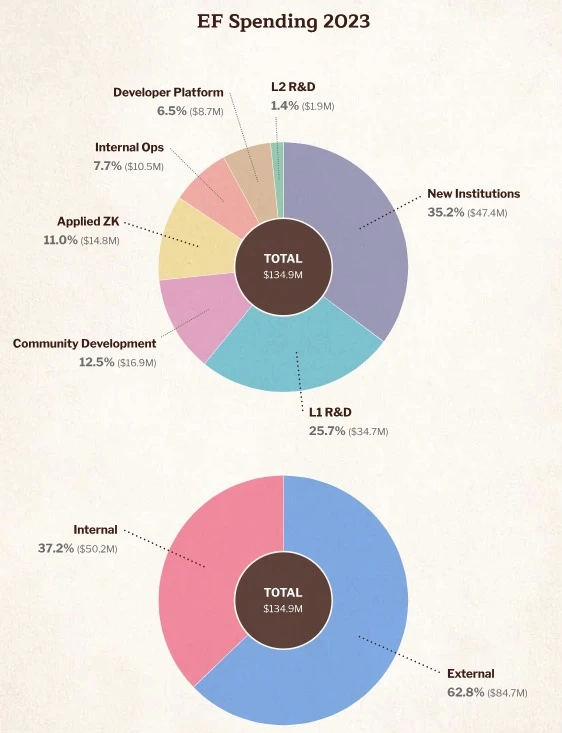
Explanation of Expenditure Categories
L1 R&D: This category includes all research and development related to mainnet upgrades, Geth, internal security research, cryptographic R&D, economic modeling, and mechanism design, as well as long-term research to achieve the Ethereum community roadmap and funding for external execution and consensus layer clients. Additionally, it includes many other funding projects for external teams, such as network stress testing and external research in specialized cryptography.
L2 R&D: This includes support provided to internal teams that contribute to L2 research and development, as well as funding for external groups to improve the L2 ecosystem. These funding projects cover educational resources, block explorers, developer tools, security audits, and more.
Application ZK R&D: This includes funding support for privacy and scalability exploration teams, with projects such as MACI, Anon Aadhaar, TLS Notary, etc. Additionally, multiple grants have been provided, ranging from ZK development tools, ZK ceremony design user experience, to ZK application proof of concept.
Developer Platform: Covers all work related to enhancing Ethereum as a developer platform, including projects for development libraries such as Solidity, Remix, Ethers.js, and Web3.js, as well as support for the Python ecosystem.
Community Development: Includes various work supporting different parts of the Ethereum community, covering interactions with the core protocol community (such as supporting the staking community), the Next Billion team, Devcon and Devconnect events, Ethereum.org, and other educational resources. Additionally, multiple grants have been provided to local and regional Ethereum communities and events worldwide.
Internal Operations: Covers general expenses supporting all EF teams, including all costs related to internal and external legal, accounting, and financial services, as well as organization-wide subscriptions and service providers, such as data services, operational tools, and technical infrastructure. It also includes investment expenses related to financial management strategies and salaries for all operational and administrative personnel.
New Institutions: Includes funding for new institutions to support the Ethereum ecosystem. During 2022 and 2023, this included funding for organizations such as Nomic Foundation, 0xPARC, L2BEAT, and others.
Ethereum Foundation Financial Reserves
As of October 31, 2024, the total financial reserves held by the Ethereum Foundation (EF) amount to approximately $970.2 million, which includes $788.7 million in crypto assets (including the remaining 26,701 ETH committed to customer incentive programs) and $181.5 million in non-crypto investments and assets.
The vast majority (99.45%) of the crypto assets are held in ETH. These ETH represent 0.26% of the total ETH supply as of October 31, 2024.
We choose to hold most of our financial reserves in ETH to reflect the Foundation's confidence in Ethereum's potential, and the ETH we hold represents this long-term perspective.
At the same time, the goal of the Foundation's financial reserves is to provide funding support for important public goods in the Ethereum ecosystem for many years to come.
To achieve this goal, we follow a conservative financial reserve management policy to ensure that there are sufficient resources even during prolonged market downturns. This requires us to regularly sell ETH to ensure that reserve funds are adequate for the coming years, while programmatically increasing fiat reserves during bull markets to support expenditures during bear markets.
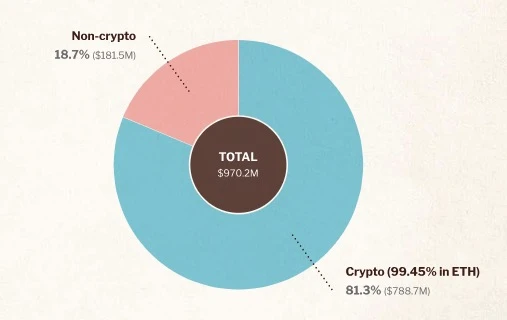
The Rise of the Ecosystem, Facing Challenges
Ethereum Ecosystem
In recent years, the Ethereum ecosystem has been continuously evolving. Now, many organizations and institutions contribute to Ethereum and push its boundaries forward, including companies, non-profits, DAOs, L2 organizations, and more. Our ecosystem has never been stronger.
As the ecosystem develops, these organizations are contributing more funding to the Ethereum community.
Total Treasury of the Ethereum Ecosystem
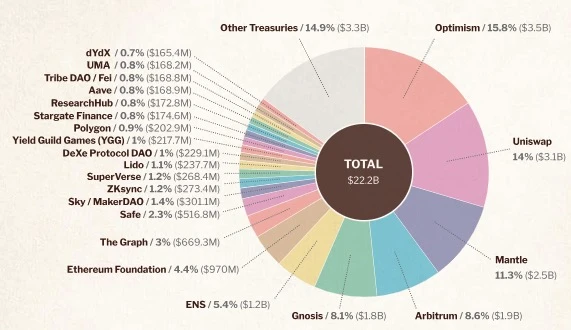
As of 2024, the Ethereum ecosystem will be supported by billions of dollars in funding from the Foundation, organizations, and DAOs.
The chart shows the total value held by project treasuries. This includes liquid amounts available for projects as well as amounts still being vested. All non-EF data is sourced from Deep DAO as of October 17, 2024 (deepdao.io/organizations).
Most project treasuries are primarily composed of the project's native tokens. This means that the total value of project treasuries far exceeds the total value that can be immediately deployed in fiat. If a project attempts to sell a large portion of its funds, it could significantly impact the price of the underlying tokens.
Conversely, the chart shows us the depth of long-term available resources in the Ethereum ecosystem. Even a small portion of capital gradually deployed over the next 10 years will provide important resources for the development and maintenance of the Ethereum ecosystem.
Total Funding Deployed in the Ethereum Ecosystem in 2022-2023
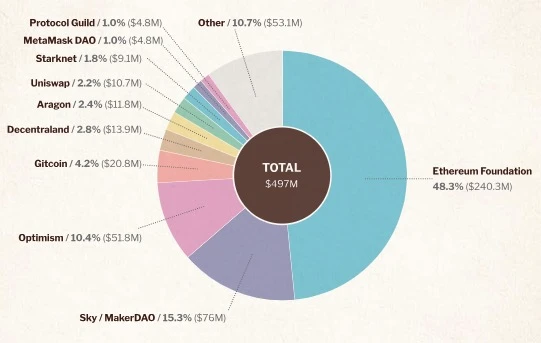
In 2022 and 2023, organizations within the Ethereum ecosystem deployed over $497 million to support projects across the community.
In collecting this data, we used a broad definition of ecosystem funding. This includes funding for Ethereum public goods (such as the Protocol Guild) as well as funding for projects within the larger Ethereum ecosystem (for example, funding for products built on specific L2s). This data does not include equity investments or similar funding, nor does it include airdrops from token generation events.
The dollar value is calculated using the applicable asset prices at year-end or the specific grant date when known.
This information was gathered through research of publicly available information and outreach to 94 organizations within the Ethereum ecosystem. However, existing data is quite fragmented, and some projects did not respond to our inquiries. This data also does not include internal expenditures from many organizations, which often contribute to Ethereum public goods. This data should be considered incomplete.
We included data on grant distribution platforms such as Gitcoin. Funding associated with these platforms typically comes from donations by other organizations (such as EF). We have attempted to deduplicate the data as much as possible to avoid double counting.
免责声明:本文章仅代表作者个人观点,不代表本平台的立场和观点。本文章仅供信息分享,不构成对任何人的任何投资建议。用户与作者之间的任何争议,与本平台无关。如网页中刊载的文章或图片涉及侵权,请提供相关的权利证明和身份证明发送邮件到support@aicoin.com,本平台相关工作人员将会进行核查。




